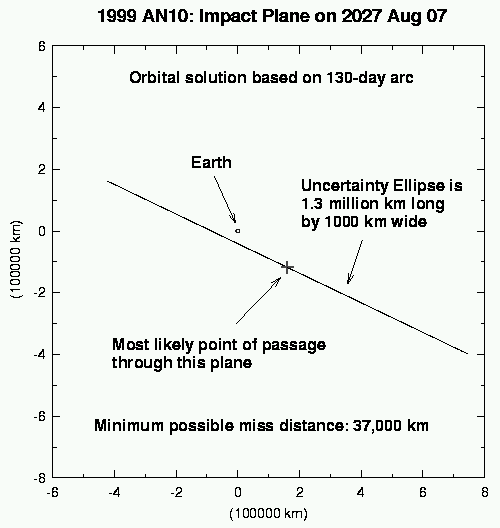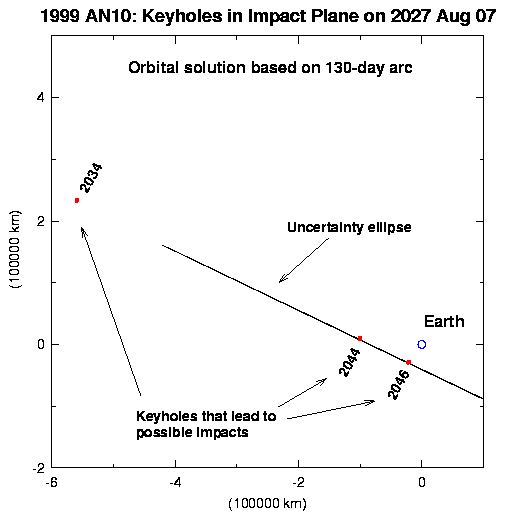




New orbital analyses for the kilometer-sized asteroid 1999 AN10 have revealed a remote chance that this object might collide with the Earth in the year 2044 or 2046. Although this asteroid will be monitored in the future, it is not thought to be a serious hazard to Earth at this time. Researchers Andrea Milani, Steven Chesley and Giovanni Valsecchi in Italy, as well the undersigned at JPL, have identified these new impacting possibilities by using new observational data, and by projecting the asteroid’s motion somewhat farther into the future than before. New measurements of 1999 AN10, made over the last week and a half by amateur astronomer Frank Zoltowksi in Australia, have allowed astronomers to make significantly more precise orbital calculations, and the revised predictions indicate that the asteroid could approach the Earth particularly closely on August 7, 2027. The orbital motions of the Earth and the asteroid do not permit a collision in 2027, but the close approach will certainly change the asteroid’s orbital path. During the past week, researchers have focused on the range of possible paths the asteroid could follow after 2027.
The accompanying diagram shows the uncertainty in the predicted close approach in 2027. The asteroid must pass through the plane of the diagram somewhere within an extremely skinny uncertainty ellipse, which appears simply as a line segment. New measurements taken over the weekend have moved the center of the ellipse (the most likely point of passage) out to a distance of about 200,000 km from the Earth, significantly farther than last week’s estimate. The predicted point of passage may continue to bounce around within the ellipse as new data are added, but it cannot decrease below a minimum of about 37,000 km from the Earth’s center.

The newly identified impacting possibilities for August 6, 2044 and August 7, 2046 each require passage through only a single keyhole in the 2027 ellipse, and the probabilities of impact for these cases are correspondingly larger, on the order of one chance in 500,000 for 2044, and one chance in five million for 2046. These odds of collision are larger than those for any other object, but they are still less than one hundredth the chance of an undiscovered asteroid of equivalent size striking the Earth sometime before 2044.
In summary, asteroid 1999 AN10 does not pose a serious impact hazard at this time, but observers should continue to monitor its motion over the next few decades, and the chance of impact should be carefully reassessed whenever new data become available.